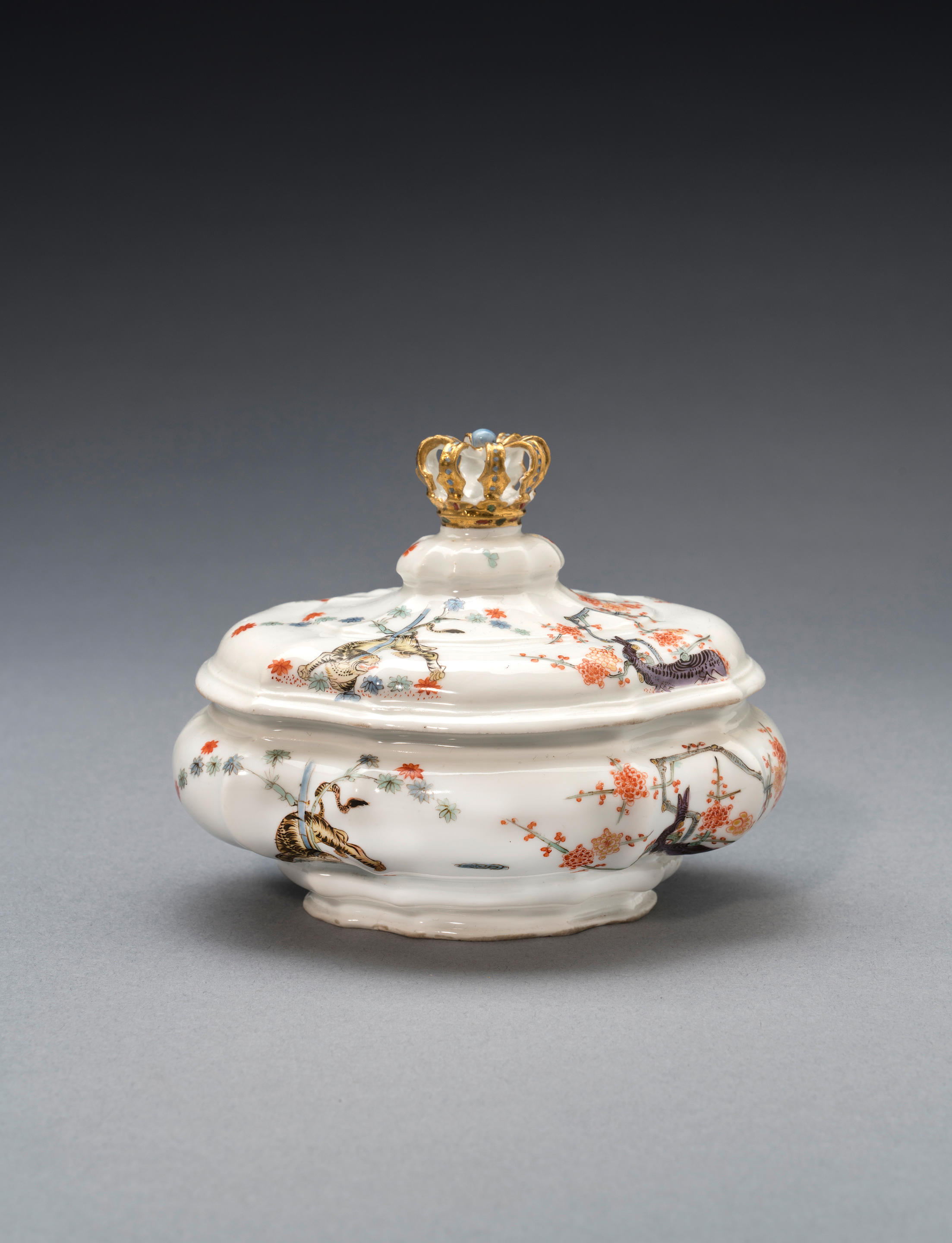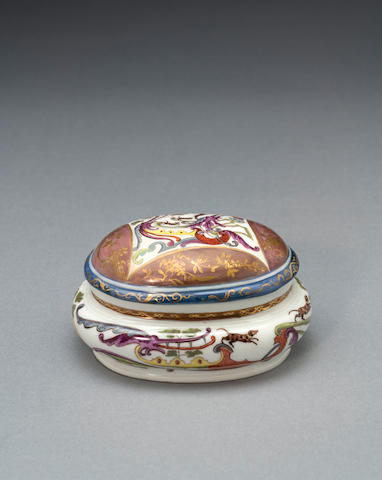A Meissen sugar bowl and cover from the 'Sulkowski Service', circa 1735-38 Of lobed shape with a Sulkowski Ozier moulded border to the rim and gilt band to the inside, painted in kakiemon style with scattered flower sprigs, on four scrollwork feet issuing from crowned female masks, the lobed cover painted with the arms of Sulkowski and Jettingen four times and scattered flower sprigs, a polychrome flowerbud finial issuing from moulded leaves, 14.8cm high, 15.5cm long, crossed swords mark in underglaze-blue (restoration to one foot) (2) Fußnoten Provenance: The Property of a Lady of Title, Sotheby's London, 23 May 1967, lot 40; With Robert Williams; Private Collection, North of England; With Robert Williams Sussex, 1994; Dr. Roy Byrnes Collection, California, sold Christie's London, 12 May 2010, lot 83 Literature: Hugo Morley-Fletcher, Meissen Porcelain in Colour (1971), p. 62 Another sugar box is in the Wawel Royal Castle State Art Collection (ZKWawel 9391). The Sulkowski Service was the first large, privately commissioned armorial service to have been designed to order at the Meissen factory. It preceded the more famous Swan Service by several years and was the first that was not intended for the Elector. It was famously used on 28 February 1737 for the wedding of Prince Stanislaus III. Lubomirski and Baroness von Stein zu Jettingen, a relative of Sulkwoski's wife, that was attended by Augustus III. It was the first time a complete table service of porcelain without any silver vessels was used (G. Reinheckel, Meissener Prunkservice (1990), p. 86). Alexander Joseph Graf von Sulkowski (1695-1762) was born into a prominent Polish noble family and entered royal service as a page at the Warsaw court. From 1711, he was raised in the household of the Electoral Prince Friedrich Augustus, the heir of Augustus the Strong, of whom he became a close friend. He became a Gentleman of the Bedchamber in 1726, was raised to a (Polish) count in 1732 and, following the accession of Friedrich Augustus in 1733, was made Privy Councillor, Minister of State, Cabinet Minister and an Imperial Count. Sulkowski also was the recipient of numerous gifts and orders from both Augustus the Strong and his successor, Friedrich Augustus, including Schloß Übigau and the Flemmingsche Palais in Dresden, as well as the Polish Order of the White Eagle and the Order of St. Heinrich. Sulkowski married (firstly) in 1728 a Lady in Waiting of the Electoral Princess, Maria Anna Franziska Catharina Freifrau von Stein zu Jettingen (1712-41), whose arms appear on the service together with those of her husband. The first explicit mention of the service in Kaendler's work notes (Arbeitsberichte) appears to be the large sugar box and cover "belonging to the order of His Excellency the Count Von Solkofsky (sic)" in September 1735. The manufactory inspector reported in May 1736 that although Kaendler, as well as the best Formers and Cleaners had worked on the service for a year and a half, it was not going to be possible to finish everything as Count Brühl had ordered a new service of "entirely new design" and the store rooms urgently needed tablewares, small animals, figures and birds for sale (quoted by Ingelore Menzhausen, In Porzellan verzaubert, p.189 - see facing page for the tureen from the service in the Pauls Collection, Basel). The delivery specification, signed by Höroldt and dates 8 February 1738, lists six sugar boxes (quoted by Reinheckel, op. cit. , n. 102, p. 198). The basket-moulded borders, now known as "Sulkowsky-Ozier", seem to have been used from around 1732. The Sulkowski Service was the subject of one of the very earliest scholarly monographs on Meissen porcelain, when it was published by Julius Lessing in 1888 ("Das Porzellangeschirr Sulkowski", in Kunstgewerbeblatt, vol.4, pp.43-8). Much of the service was apparently sold shortly afterwards, though a substantial portion was preserved in the family home until it was sold by Sotheby's London ("The Propert
A Meissen sugar bowl and cover from the 'Sulkowski Service', circa 1735-38 Of lobed shape with a Sulkowski Ozier moulded border to the rim and gilt band to the inside, painted in kakiemon style with scattered flower sprigs, on four scrollwork feet issuing from crowned female masks, the lobed cover painted with the arms of Sulkowski and Jettingen four times and scattered flower sprigs, a polychrome flowerbud finial issuing from moulded leaves, 14.8cm high, 15.5cm long, crossed swords mark in underglaze-blue (restoration to one foot) (2) Fußnoten Provenance: The Property of a Lady of Title, Sotheby's London, 23 May 1967, lot 40; With Robert Williams; Private Collection, North of England; With Robert Williams Sussex, 1994; Dr. Roy Byrnes Collection, California, sold Christie's London, 12 May 2010, lot 83 Literature: Hugo Morley-Fletcher, Meissen Porcelain in Colour (1971), p. 62 Another sugar box is in the Wawel Royal Castle State Art Collection (ZKWawel 9391). The Sulkowski Service was the first large, privately commissioned armorial service to have been designed to order at the Meissen factory. It preceded the more famous Swan Service by several years and was the first that was not intended for the Elector. It was famously used on 28 February 1737 for the wedding of Prince Stanislaus III. Lubomirski and Baroness von Stein zu Jettingen, a relative of Sulkwoski's wife, that was attended by Augustus III. It was the first time a complete table service of porcelain without any silver vessels was used (G. Reinheckel, Meissener Prunkservice (1990), p. 86). Alexander Joseph Graf von Sulkowski (1695-1762) was born into a prominent Polish noble family and entered royal service as a page at the Warsaw court. From 1711, he was raised in the household of the Electoral Prince Friedrich Augustus, the heir of Augustus the Strong, of whom he became a close friend. He became a Gentleman of the Bedchamber in 1726, was raised to a (Polish) count in 1732 and, following the accession of Friedrich Augustus in 1733, was made Privy Councillor, Minister of State, Cabinet Minister and an Imperial Count. Sulkowski also was the recipient of numerous gifts and orders from both Augustus the Strong and his successor, Friedrich Augustus, including Schloß Übigau and the Flemmingsche Palais in Dresden, as well as the Polish Order of the White Eagle and the Order of St. Heinrich. Sulkowski married (firstly) in 1728 a Lady in Waiting of the Electoral Princess, Maria Anna Franziska Catharina Freifrau von Stein zu Jettingen (1712-41), whose arms appear on the service together with those of her husband. The first explicit mention of the service in Kaendler's work notes (Arbeitsberichte) appears to be the large sugar box and cover "belonging to the order of His Excellency the Count Von Solkofsky (sic)" in September 1735. The manufactory inspector reported in May 1736 that although Kaendler, as well as the best Formers and Cleaners had worked on the service for a year and a half, it was not going to be possible to finish everything as Count Brühl had ordered a new service of "entirely new design" and the store rooms urgently needed tablewares, small animals, figures and birds for sale (quoted by Ingelore Menzhausen, In Porzellan verzaubert, p.189 - see facing page for the tureen from the service in the Pauls Collection, Basel). The delivery specification, signed by Höroldt and dates 8 February 1738, lists six sugar boxes (quoted by Reinheckel, op. cit. , n. 102, p. 198). The basket-moulded borders, now known as "Sulkowsky-Ozier", seem to have been used from around 1732. The Sulkowski Service was the subject of one of the very earliest scholarly monographs on Meissen porcelain, when it was published by Julius Lessing in 1888 ("Das Porzellangeschirr Sulkowski", in Kunstgewerbeblatt, vol.4, pp.43-8). Much of the service was apparently sold shortly afterwards, though a substantial portion was preserved in the family home until it was sold by Sotheby's London ("The Propert














Try LotSearch and its premium features for 7 days - without any costs!
Be notified automatically about new items in upcoming auctions.
Create an alert